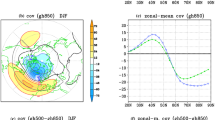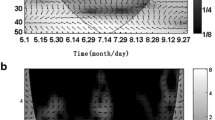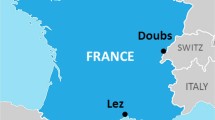Abstract
Mathematical analysis of a predominantly bimodal chaotic attractor, Lu system, was carried out to investigate a possible application of the model as a prototype of monsoon intra-seasonal oscillation (ISO). Bifurcation structures of the system are explored as the system parameter c and the forcing parameter F are varied. Stability criteria of equilibrium points of the forced Lu system are also explored in detail. A sensitivity study is carried out, by changing forcing parameter F, to explore relationships between some of the derived variables of the model and, based on such relationships, an empirical rule is used for extended range prediction. Analogous variables are also derived from the ISO data and prediction results are compared. Application of the prediction rule of regime transition to the observed ISO and chaotic model data is purely based on the bimodal characteristics of ISO and neglects some of the intricate mechanisms therein. We have found that a forced Lu system can be a good prototype in the prediction of peak anomaly of the monsoon ISO when growth rates around a threshold value are taken as predictors.








Similar content being viewed by others
References
Allen M, Kattleborough J, Stainforth D (2002) Model error in weather and climate forecasting. Predictability of weather and climate. Cambridge University Press, London, pp 391–427
Celikovsky S, Chen G (2002) On a generalized Lorenz canonical form of chaotic systems. Int J Bifurcat Chaos 12:1789–1812
Celikovsky S, Vanecek A (1994) Bilinear systems and chaos. Kybernetika 30:403–424
Charney JG, DeVore JG (1979) Multiple flow equilibria in the atmosphere and blocking. J Atmos Sci 36:1205–1216
Chen G, Ueta T (1999) Yet another chaotic attractor. Int J Bifurcat Chaos 9:1465–1466
Crommelin DT (2002) Homoclinic dynamics: a scenario for atmospheric ultra low frequency variability. J Atmos Sci 59:1533–1549
De Swart HE (1988) Low order spectral models of the atmospheric circulation: a survey. Acta Appl Math 11:49–96
Dwivedi S, Mittal AK, Goswami BN (2006) An empirical rule for extended range prediction of duration of Indian summer monsoon breaks. Geophys Res Lett. doi:10.1029/2006GL027035
Gadgil S, Rao PRS (2000) Famine strategies for a variable climate—a challenge. Curr Sci 78:1203–1215
Goswami BN, Xavier PK (2003) Potential predictability and extended range prediction of Indian summer monsoon breaks. Geophys Res Lett. doi:10.1029/2003GL017810
Itoh H, Kimoto M (1999) Weather regimes, low frequency oscillations, and principal patterns of variability. J Atmos Sci 56:2684–2705
Kuznetsov YA (1998) Elements of Applied Bifurcation Theory. Springer, New York
Lagras B, Ghil M (1985) Persistent anomalies, blocking and variations in the atmospheric predictability. J Atmos Sci 42:433–471
Liebmann B, Smith CA (1996) Description of a complete (interpolated) outgoing long wave radiation dataset. Bul Am Meterol Soc 77:1275–1277
Lorenz EN (1963) Deterministic nonperiodic flow. J Atmos Sci 20:130–141
Lu J, Chen G (2002) A new chaotic attractor coined. Int J Bifurcat Chaos 12:659–661
Lu J, Chen G, Zhang S (2002a) Compound structure of a new chaotic attractor. Chaos Solitons Fractals 14:669–672
Lu J, Chen G, Zhang S (2002b) Controlling between the Lorenz and Chen system. Int J Bifurcat Chaos 12:1417–1422
Mittal AK, Dwivedi S, Pandey AC (2003) A study of forced Lorenz model of relevance of monsoon predictability. Ind J Radio Space Phys 32:209–216
Mittal AK, Dwivedi S, Pandey AC (2005) Bifurcation analysis of a paradigmatic model of monsoon prediction. Nonlin Process Geophys 12:707–715. doi:10.5194/npg-12-707-2005
Mittal AK, Dwivedi S, Yadav RS (2007) Probability distributions for the number of cycles between successive regime transitions for the Lorenz model. Phys D 233:14–20
Mittal AK, Mukherjee S, Shukla RP (2011) Bifurcation analysis of some forced Lu system. Commun Nonlinear Sci Numer Simulat 16:787–797. doi:10.1016/j.cnsns.2010.04.016
Palmer TN (1994) Chaos and predictability in forecasting the monsoon. Proc Ind Natl Sci Acad 60A:57–66
Shil’nikov A, Nicolis G, Nicolis C (1995) Bifurcation and predictability analysis of a low order atmospheric circulation model. Int J Bifurcat Chaos 5:1701–1711
Shukla RP, Mukherjee S, Mittal AK (2010) Comparison of generalized competitive modes and return maps for characterizing different types of chaotic attractors in the Chen system. Int J Bifurcat Chaos. doi:10.1142/S0218127410026022
Thompson JMT, Stewart HB (2002) Nonlinear Dynamics and Chaos. Wiley, England
van Veen L (2003) Baroclinic flow and the Lorenz 84 model. Int J Bifurcat Chaos 13:2117–2139
Webster PJ, Hoyos C (2004) Prediction of monsoon rainfall and river discharge on 15–30 day time scales. Bull Am Meteorol Soc 85:1745–1765
Wilks DS (2005) Statistical Methods in the Atmospheric Sciences. International Geophysics Series. Academic Press, Oxford
Yadav RS, Dwivedi s, Mittal AK (2005) Prediction rules for regime changes and length in a new regime for Lorenz model. J Atmos Sci 62:2316–2321
Acknowledgments
The authors thank the Indian National Center for Ocean Information Services (INCOIS) and National Center for Ocean and Antarctic Research (NCOAR), MoES, Government of India, for financial support. S. Mukherjee thanks Dr. Suneet Dwivedi, Department of Atmospheric and Ocean Science, University of Allahabad, for useful discussions.
Author information
Authors and Affiliations
Corresponding author
Additional information
Responsible editor: J. Fasullo.
Rights and permissions
About this article
Cite this article
Mukherjee, S., Shukla, R.P., Mittal, A.K. et al. Mathematical analysis of a chaotic model in relevance to monsoon ISO. Meteorol Atmos Phys 114, 83 (2011). https://doi.org/10.1007/s00703-011-0159-3
Received:
Accepted:
Published:
DOI: https://doi.org/10.1007/s00703-011-0159-3




